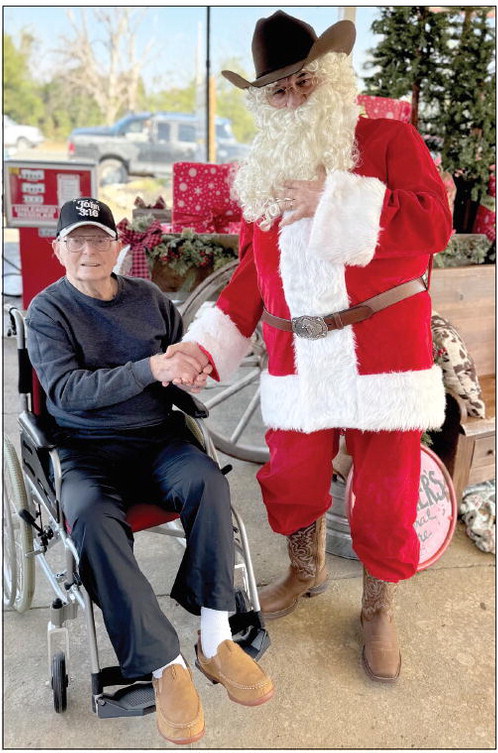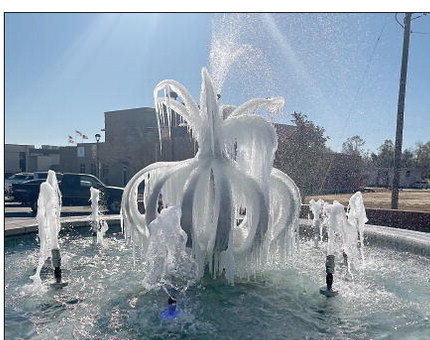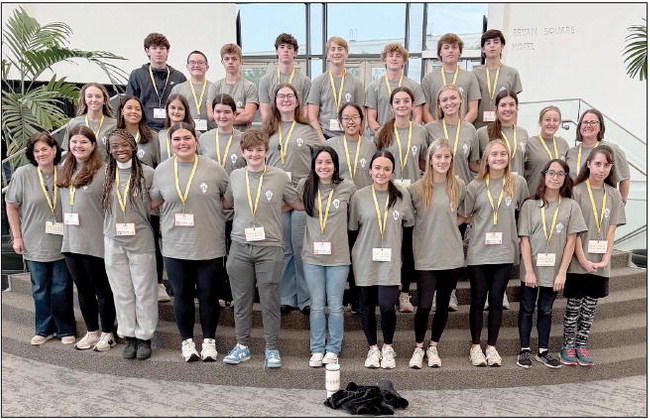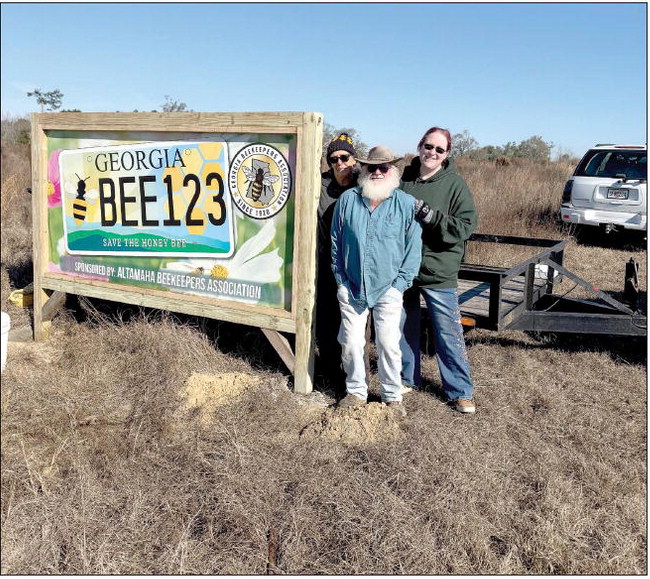Vassey Proposes Cost-Saving Measures
mrandolphadvance@gmail.com
During the Montgomery County Board of Commissioners Work Session on May 8, Commissioner Amie Vassey presented the fellow commissioners with four cost-saving measures, which she stated could save the county up to $500,000.
Vassey told the commissioners and the meeting attendees that in April, she had challenged her fellow commissioners to think of ideas to save money within the County, and to share those ideas at the work session.
Commission Chairman Ginger Morris spoke first about her idea to save money within the county. “I know it is our fiduciary responsibility, so I think that every time we get together and we try to make decisions, we make it based on what is best for our money’s worth. I think that once we look at budgets and budget season comes up again, maybe asking [county departments and offices] to have a percent decrease and save overall, that way everybody participates in the reduction and not just us calling it all,” she remarked.
Vassey thanked Morris for her ideas and informed attendees that Morris had also proposed having a retreat for the commissioners so that they could talk about these sorts of changes in the county.
Vassey proposed four cost-saving measures within the county. The first measure which she suggested was to use the funding received by the county for the Silicon Ranch Solar Farm to fund the Montgomery County Development Authority.
“If this is going to be a continual thing – one thing I recently learned at an economic development class that I went to is that many counties have a completely separated, unmerited funding source for their development authority. So, in other words, the taxpayers do not pay property taxes to fund their development authority. It is funded in a completely different way,” she stated, as she explained many counties funded their development authorities with a hotel/motel tax. “This solar money, if it ends up being the true $200,000+ that we were told that it will be, would double the development authority’s budget with no cost to the homeowners. We would potentially be saving homeowners $108,000, $110,000 – whatever we are currently tacking on to the budget to fund our development authority. I think that would be a very easy thing to do. The development authority worked really hard to gain that solar money, so I think that it’s very fitting that it would be used to fund their department while also helping the residential taxpayers of this county.”
Commissioner Leland Adams commented on the idea, saying,“Currently, that money that we are receiving was put into this year’s budget so that we didn’t have to raise the millage rate. We are getting that money into the budget. So, that means that if we send that money – which is $100,000 that we are currently giving them – we will have to make up for the rest of that, which is around $200,000.”
Vassey suggested discussing the matter at future work sessions to look at the pros, cons, and details of the decision. “Our development authority – it’s no secret – they never have the funding that they need to provide impactful change in our county,” she said. “But if we earmark [this solar money] for them each year, and they start stockpiling the additional $100,000 left over each year, they will have enough money to supply a meaningful impact to our county.”
The second cost-saving measure which Vassey proposed was the merger of the Montgomery County Probate and Magistrate Courts. “In my travels of my county commissioner learning, I have found that many counties our size do not have a probate court and magistrate court separated,” she explained. “Right now, our magistrate court budget is $135,000 a year, our probate court budget is $125,000 a year. Many counties combine these and have one court system to handle both those things. A county that recently done it a few years ago is Clinch County, [and it was] widely successful. I would love if [County Manager] Heather [Scott] could reach out to them and find out how they did it, how much money they are saving. We could potentially save the county $140,000 per year to our taxpayers on our property taxes.”
Vassey also suggested reviewing the Toombs-Montgomery EMS contract, as she shared that currently, the county pays the full amount of the contract, even though the majority of the services is dispatched to city residences. “I think that we should look at that contract and see if there is a more equitable way that the city of Mount Vernon could contribute to that contract,” she remarked.
Last, Vassey suggested finding creative ways – such as tournaments and sponsorships – to help the Montgomery County Recreation Department to be self-sufficient one day. Recreation Department Project Update In addition to this, Montgomery County Manager Heather Scott provided the commissioners with the most recent plans and renderings for the rehabilitation of the J.M. Fountain Park, which houses the Montgomery County Recreation Department.
The Montgomery County Board of Commissioners previously received a grant for the revitalization of the recreation department, and has been working with Roberts Civil Engineering to create plans for these changes.
County Manager Scott told the commissioners that the drawing had been reviewed by Montgomery County Recreation Director Kendall Bennamon, who suggested several changes on the original plans, which are broken into three phases. Bennamon’s desired changes to the park include asking that the pond and parking in the back be removed so that fields may be moved back, a concessions/score keeping tower in the middle, and parking be placed in the front.
Commissioner Vassey spoke on some concerns she had regarding the project. “I’m having a little bit of heartburn in the way that they do their invoices. I do see that they have a general summaries of the duties that they performed, then they have these dollar amounts in lump amounts at the bottom. I would really like to see those items up under Montgomery County Recreation Department summary. I’d like to know a little more specifically about what this is for. Is this their general habit for invoices? Are you comfortable with that?” she asked Scott.
Scott stated that she wasn’t fully comfortable with the invoicing but said she could ask that they be more detailed. She also offered to provide Vassey the project contract, which had more detail on how things were done.
Vassey then turned to address the public. “To be clear for the citizens who are present, we have already spent over $85,000 with Roberts Civil Engineering as it pertains to the recreation plans and facility. And if you drive out there, you can see that nothing physically has been done, all of this is for engineering fees and planning and things of this nature. Just want you guys to be aware of that,” she commented.
She also questioned why she had not received concept plans from her requests for the documents in January and February, as the invoice stated that the plans existed at that time. Scott told Vassey that she had distributed any plans or information given to her with the commissioners.
Public Comments
During the work session, K.C. Seabury was the only citizen who gave public comments. He began by telling the commissioners that he wished to share a letter which he had received from them.
“It says, ‘Good afternoon, Mr. Seabury. Typically, public comments at a commissioners’ meeting are not considered formal requests. However, they can provide valuable feedback and influence decision-making. While comments may not be an official request, they can be used to convey concerns or opinions to the commissioners. We do ask that any request be made to the commissioners office so that we can respond in a timely manner,’” he read.
Seabury continued, “That’s just a portion of the letter I received, and I am going to try my best to respect what it’s saying to me as I understand it. I would like to thank [Montgomery County Road Department Director] Mr. Robert [Lewis] for getting a load of dirt on top of the water line that had been requested 3 times. Y’all tried once and missed it because you said you couldn’t find the place; so, thank you. With the remainder of my time, I would like to spend sharing the things that fit into the guidelines that I understand have been given to me of what citizens can bring to the county commissioners.”
The citizen stood in silence until most of his allotted 3 minutes was completed.
“So, in keeping with the guidelines that I have been given, the things that I have to bring are in the form of questions in order for me to gain the information to share what I need to share now, ask, and convey. Since I have been instructed that those are not appropriate and I’m not going to be able to share those, again, I thank you for your time,” he concluded.







